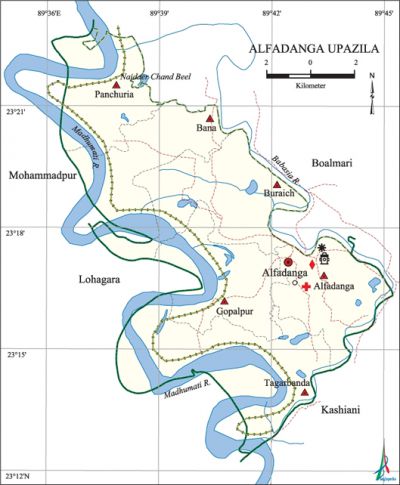Alfadanga Upazila
Alfadanga Upazila (faridpur district) area 127.87 sq km, located in between 23°13' and 23°21' north latitudes and in between 89°36' and 89°41' east longitudes. It is bounded by boalmari upazila on the north, lohagara (narail) upazila on the south and west, kashiani (gopalganj) upazila on the east.
Population Total 108302; male 51603, female 56699; Muslim 100618, Hindu 7679, Buddhist 1 and Christian 4.
Water bodies madhumati and Babashia are the main rivers and Naidear Chand beel is notable.
Administration Alfadanga Thana was formed in 1960 and it was turned into an upazila in 1984.
| Upazila | ||||||||
| Municipality | Union | Mouza | Village | Population | Density (per sq km) | Literacy rate (%) | ||
| Urban | Rural | Urban | Rural | |||||
| - | 6 | 86 | 122 | 6905 | 101397 | 847 | 70.8 | 53.7 |
| Upazila Town | ||||
|
Area |
Mouza |
Population |
Density |
Literacy rate (%) |
| 4.39 | 2 | 6905 | 1573 | 70.8 |
| Union | ||||
| Name of union and GO code | Area (acre) | Population | Literacy rate (%) | |
| Male | Female | |||
| Alfadanga 10 | 4349 | 8076 | 8939 | 59.1 |
| Gopalpur 42 | 4690 | 8670 | 9893 | 57.9 |
| Tagarbanda 84 | 7407 | 8617 | 9852 | 57.8 |
| Panchuria 52 | 4019 | 7685 | 8212 | 52.1 |
| Bana 21 | 5015 | 7836 | 8312 | 50.9 |
| Buraich 31 | 6068 | 10719 | 11491 | 51.4 |
Source Bangladesh Population Census 2011, Bangladesh Bureau of Statistics.

War of Liberation During the War of Liberation in 1971 the Pakistani soldiers in collaboration with the razakars tortured and killed a number of people; they also plundered and set on fire many houses. On 6 September the freedom fighters attacked the Lahutia Nakshal Camp occupied by the Pak army and killed Nakshal leader Badsha Jamadar. On 5 November the freedom fighters attacked Pak army Camp at Bhatiapara Wireless Office; this time 13 freedom fighters were killed and 10 were wounded while the Pak army fired from the plane. On 11 November the freedom fighters, with the help of the allied forces, tried to capture the Bhatiapara Camp. On the night of 18 December Lt. Col Kamal was seriously wounded in a frontal encounter between the allied forces and the Pak army. Alfadanga was liberated on 18 December 1971.
For details: see আলফাডাঙ্গা উপজেলা, বাংলাদেশ মুক্তিযুদ্ধ জ্ঞানকোষ (Encyclopedia of Bangladesh War of Liberation), বাংলাদেশ এশিয়াটিক সোসাইটি, ঢাকা ২০২০, খণ্ড ১।
Religious institutions Mosque 160, temple 20. The mazar of Bedan Shah (R) is notable.
Literacy rate and educational institutions Average literacy 54.8%; Male 55.4%, female 54.4%. Educational institutions: college 2, secondary school 12, primary school 55, madrasa 10.
Newspaper and periodicals Alfadanga Darpan and Kalakantha.
Cultural organizations Club 30, cinema hall 1, women's organisation 17, officers' club 1, playground 18.
Main sources of income Agriculture 56.15%, non-agriculture labourer 2.17%, commerce 11.01%, transport and 3.85%, service 16.31%, industry 0.92%, construction 1.87%, religious service 0.31%, rent and remittance 1.41% and others 5.99%.
Ownership of agricultural land Landowner 60.95%, landless 39.05%; agricultural landowner: urban' 39.10%, rural 62.24%.
Main crops Paddy, jute, ground nut, wheat, potato, kalai, onion, garlic, sugarcane.
Extinct or nearly extinct crops China, kaun, arohar, barley, indigo.
Main fruits Mango, black-berry, jackfruit, guava, jamrul, plum.
Fisheries, dairies and poultries Fishery 30, dairy 40, poultry 8, others 250.
Communication facilities Pucca road 95 km, semi-pucca road 19 km, mud road 271 km; waterways 25 km.
Extinct or nearly extinct traditional transport Boat, palanquin, horse carriage, bullock cart.
Cottage industries Goldsmith, blacksmith, potteries, bamboo work, cane work, welding etc.
Hats, bazars and fairs Total hats and bazars are 13, most noted hats are Gopalpur, Alfadanga and Shirgram hats.
Main exports Onion, garlic, date molasses, palm molasses, potato, groundnut, jute.
Access to electricity All the unions of this upazila are under electricity net-work. However 43.1% of the dwelling households only have access to electricity.
Sources of drinking water Tube-well 98.0%,%, tap 0.2% and others 1.8%.
Sanitation 91.4% of dwelling households of the upazila use sanitary latrines and 6.9% of dwelling houses use non-sanitary latrines; 1.7% of households do not have sanitation facilities.
Heath centres Upazila health complex 1, union health and family welfare centre 3, satellite clinic 4, temporary health centre 2,' brac health centre 1, clinic 3.
NGO activities brac. [AU Haider Chowdhury]
References Bangladesh Population Census 2001 and 2011, Bangladesh Bureau of Statistics; Cultural survey report of Alfadanga Upazila 2007.
